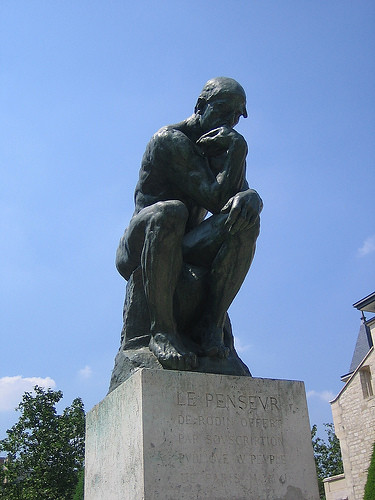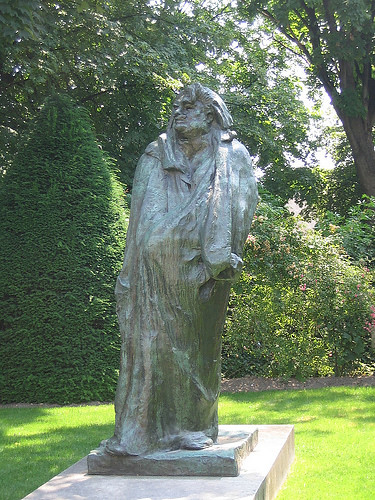Musée Rodin boasted not only many sculptures by Rodin, more readily celebrated or less so, but also his many drawings, sketches and works he collected during his lifetime.
My favorite there were more conventional this time; however, I don't believe that I need to apologize - convention often had reasons.
My first choice was Le penseur (The Thinker), 1903. This sitting figure, with a height of 180 cm, was originally conceived in 1880, in smaller scale, as the crowning element of The Gates of Hell, and had the title of The Poet (Dante).
While remaining on top of the Gates of Hell, Le penseur was exhibited separately eight years later and became an independent work. It was enlarged in 1904 to current colossal scale and become an icon as easily recognized as that of Michelangelo's David.
This powerful man, sitting on top of a really tall pedestal, though pensive, was charged with tension. His exposed muscles all tensed up, his head bent purposefully forward, and his hands, in unnaturally poses, were wonderfully evocative and full of readiness to spring into action.
Most wonderful thing about seeing it in situ was to see how it setting off the lush ground of the villa, in shifting angles.
While remaining on top of the Gates of Hell, Le penseur was exhibited separately eight years later and became an independent work. It was enlarged in 1904 to current colossal scale and become an icon as easily recognized as that of Michelangelo's David.
This powerful man, sitting on top of a really tall pedestal, though pensive, was charged with tension. His exposed muscles all tensed up, his head bent purposefully forward, and his hands, in unnaturally poses, were wonderfully evocative and full of readiness to spring into action.
Most wonderful thing about seeing it in situ was to see how it setting off the lush ground of the villa, in shifting angles.

Le penseur, 1903, H. 180cm.jpg
My second favorite was also situated in the trees on the villa ground - Monument à Balzac, 1898. The sculpture itself, with the height of 270cm, was taller than the Le penseur; however, since it sat on the ground level, it was much more intimate and approachable, and precisely because of that, we had a glimpse of the humility of the great writer Rodin tried to emphasize.
This bronze Balzac, casually clothed in a shapeless robe with roughly suggested surface, stood solidly like an aged oak tree, full of ancient wisdom and understanding. He had been reduced to the bare essence and only his facial features were modeled with recognizable details, and his hands were not visible.
It was said that after Rodin had completed his work, people marveled at and praised lavishly the hands he had given Balzac. Feeling that the details had upstaged the work itself, Rodin decisively chopped off Balzac's hand(s).
Wonderful story. True or false, it did reveal the innovative approach Rodin adopted towards this national figure and perhaps it partially explained why the commission was rejected and the sad fact that Rodin never saw his monument cast in bronze.
Today, one of the most satisfying memorial monuments ever created stood quietly in the tranquil woods, surveying La Comédie humaine.
This bronze Balzac, casually clothed in a shapeless robe with roughly suggested surface, stood solidly like an aged oak tree, full of ancient wisdom and understanding. He had been reduced to the bare essence and only his facial features were modeled with recognizable details, and his hands were not visible.
It was said that after Rodin had completed his work, people marveled at and praised lavishly the hands he had given Balzac. Feeling that the details had upstaged the work itself, Rodin decisively chopped off Balzac's hand(s).
Wonderful story. True or false, it did reveal the innovative approach Rodin adopted towards this national figure and perhaps it partially explained why the commission was rejected and the sad fact that Rodin never saw his monument cast in bronze.
Today, one of the most satisfying memorial monuments ever created stood quietly in the tranquil woods, surveying La Comédie humaine.
Monument à Balzac, 1898, H. 270cm.jpg
My Favorite Museum Collection Series
>> My Favorite Museum Collection Series 33: My Favorite Paintings from Musée Picasso, Paris
<< My Favorite Museum Collection Series 31: My Favorite Art Works at Centre Pompidou, Paris






No comments:
Post a Comment